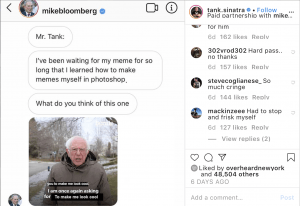Political Influencers: The Next Step in Political PR

Published on February 20, 2020, at 7:02 p.m.
by Olivia Carroll.
As media has adapted, so have political communication tactics. Calvin Coolidge became the first president to speak on the radio in 1923. Harry S. Truman became the first president to appear on television in 1947. The first White House website was introduced under the Clinton administration in 1994. Presidents and other political candidates have even taken to their own social media profiles to communicate with the American people. Now, it is time political communication teams adapt once again to invest in the newest public relations tactic: social media influencers.
While for-profit brands have fully embraced the idea of social media influencers as a public relations tactic, political communications campaigns have been slow to invest in this new social media move.

Michael Bloomberg’s communications team is one of the few investing in social media influencers. Bloomberg’s campaign has joined forces with Meme 2020, a collection of popular social media meme accounts, to select influencers to post advertisements endorsing Bloomberg’s presidential campaign. The chosen influencers include @GrapeJuiceBoys, a meme page with more than 2.7 million followers, @Tank.Sinatra, an influencer with more than 2.3 million followers, and others. The goal is to make Bloomberg look cool to younger voters. The New York Times reported that a campaign aid to Bloomberg said, “We’re trying to be innovative with how we’re translating the campaign message on social, trying to do it how the internet actually works.”
The need to follow this natural progression of media focuses on the political communications need for establishing trusted relationships, reaching a younger target audience and adapting to roadblocks associated with traditional media.
An established trust system
A key to any public relations campaign, especially in politics, is to establish a strong and trusting relationship with the public. Ryan McCormick, co-founder of Goldman McCormick Public Relations, said, “The trust that a following of an influencer has is much stronger and more consistently positive.” This connection between the social media influencers and their audiences is stronger than the relationship cultivated by a political communications campaign.
Podcasters, for example, engage with their listeners for hours at a time. Loyal listeners feel as though they have a connection with the influencers to whom they listen and are willing to believe and follow what they say.
As McCormick noted, using social media influencers in a political communications campaign is “a way of presenting the information in a friendly manner.”
A younger target audience
Younger generations are becoming an increasing percentage of those who are eligible to vote. According to the Pew Research Center, millennials and Gen Z voters will make up 37% of eligible voters for 2020.
There is already an emergence of organizations aiming to engage with younger, potential voters — voters under the age of 35 — through social media influencers. One example is NextGen America, a political action committee that aims to encourage young people to vote. NextGen America targets micro-influencers to ensure it reaches young voters in every niche that they believe traditional political campaigns ignore.
Dennis Doerfl, CEO and co-founder of Fourstarzz Media, said, “[Social media engagement] is getting more and more important as the impact of that age group increases.” In order to engage with younger voters, political communication campaigns must meet them where they are. According to the Pew Research Center, 36% of 18- to 29-year-olds report that social media is their go-to news platform.
Using social media influencers to target younger voters is the natural next step in political public relations campaigns work.
Adapting to the roadblocks
As new media continues to be introduced to the world of political campaign communications, new roadblocks continue to emerge.
Twitter Inc. has banned political ads completely. Google has prohibited political ads that target users based on age, gender and postal code. These restrictions on social media have created a roadblock for political campaign public relations tactics. However, as Doerfl noted, “If people are hungry for content, they will get to the content. All roadblocks just cause people to innovate.” The innovative answer for this roadblock: social media influencers.
As Doerfl explained, “[Social media influencers] have the right to keep talking. When there is a limitation on advertisement options, talk to influencers and get them on board.”
Twitter only allows political influencer marketing so long as there is no paid promotion attached to it. However, this does not have to be an issue for political public relations teams looking to use social media influencers as a tactic to get around the ad ban. Doerfl said, “It can be a mutually beneficial partnership with no exchange of money … no monetary compensation, but a mutually beneficial partnership to increase the following and engagement for the influencer and also for the politician.”
Political public relations strategists aim to reach younger voters by encouraging their audiences to trust them. As roadblocks continue to emerge across media platforms, it is time to evolve and follow the natural progression of media. Just as previous political communications teams evolved with radio, television and the internet, today’s political communications teams must continue to adapt and enter the world of social media influencers to reach their public relations goals.




